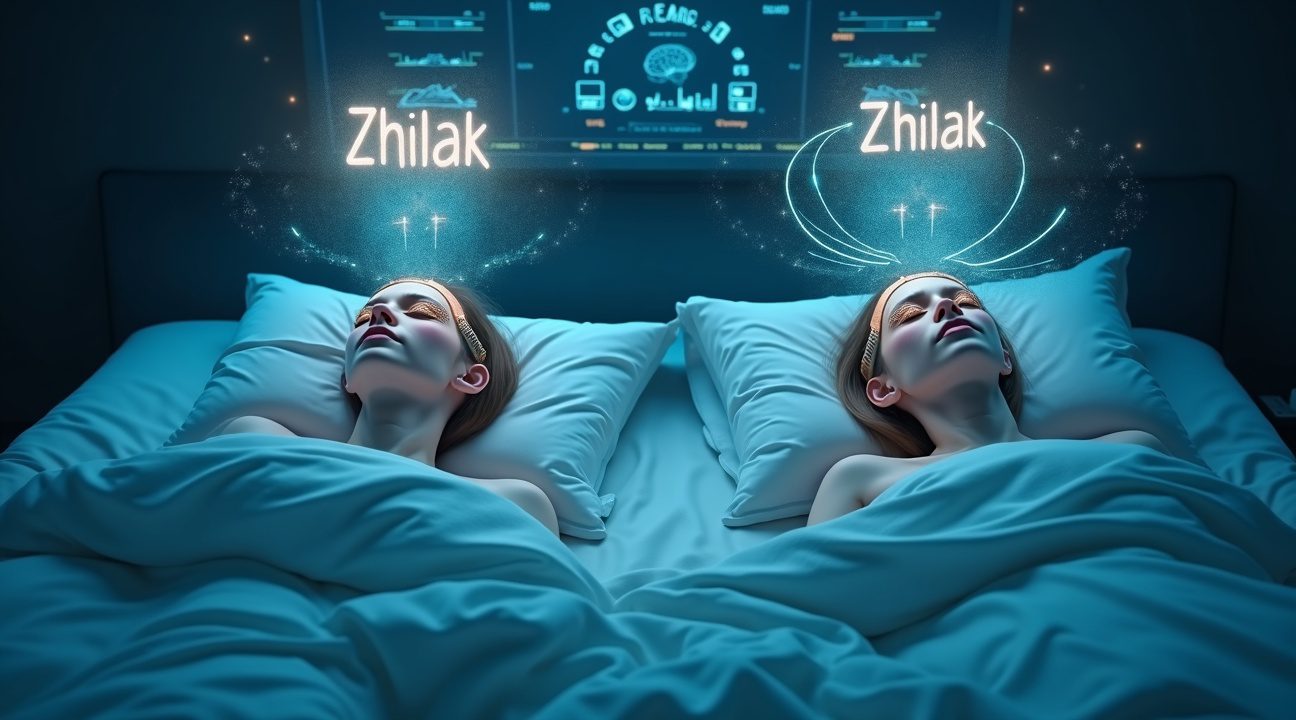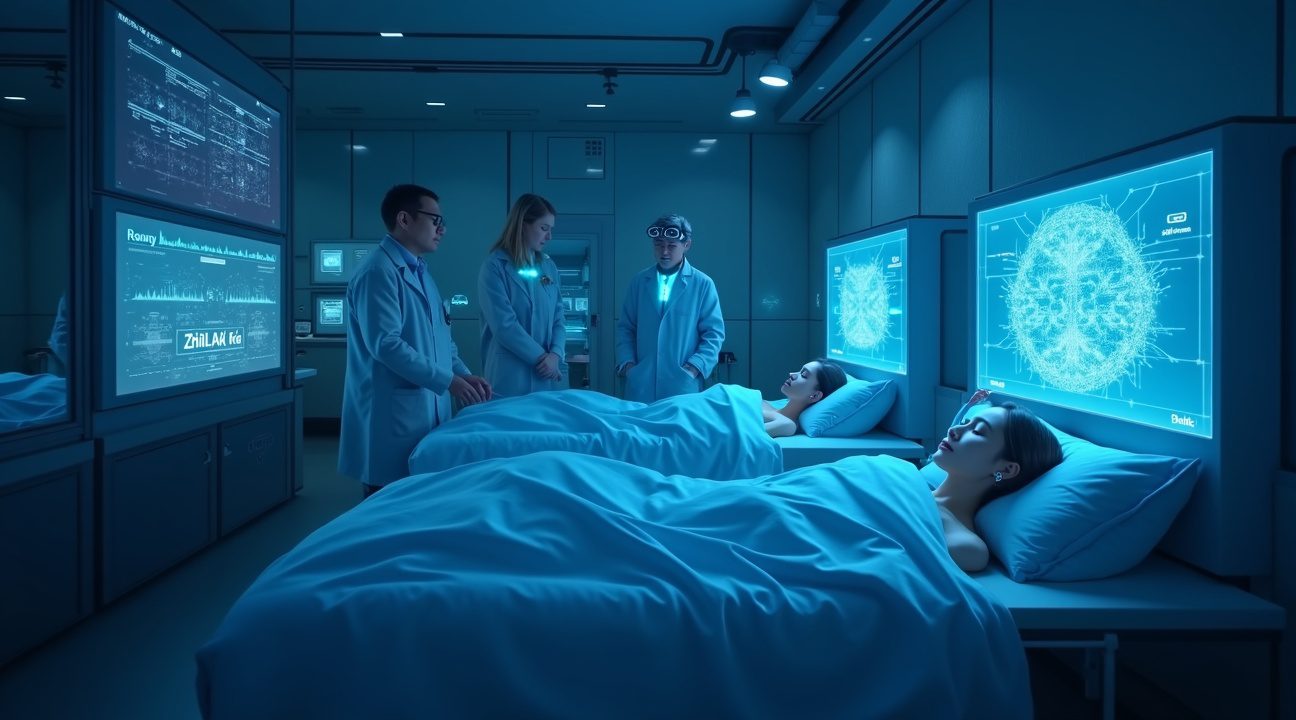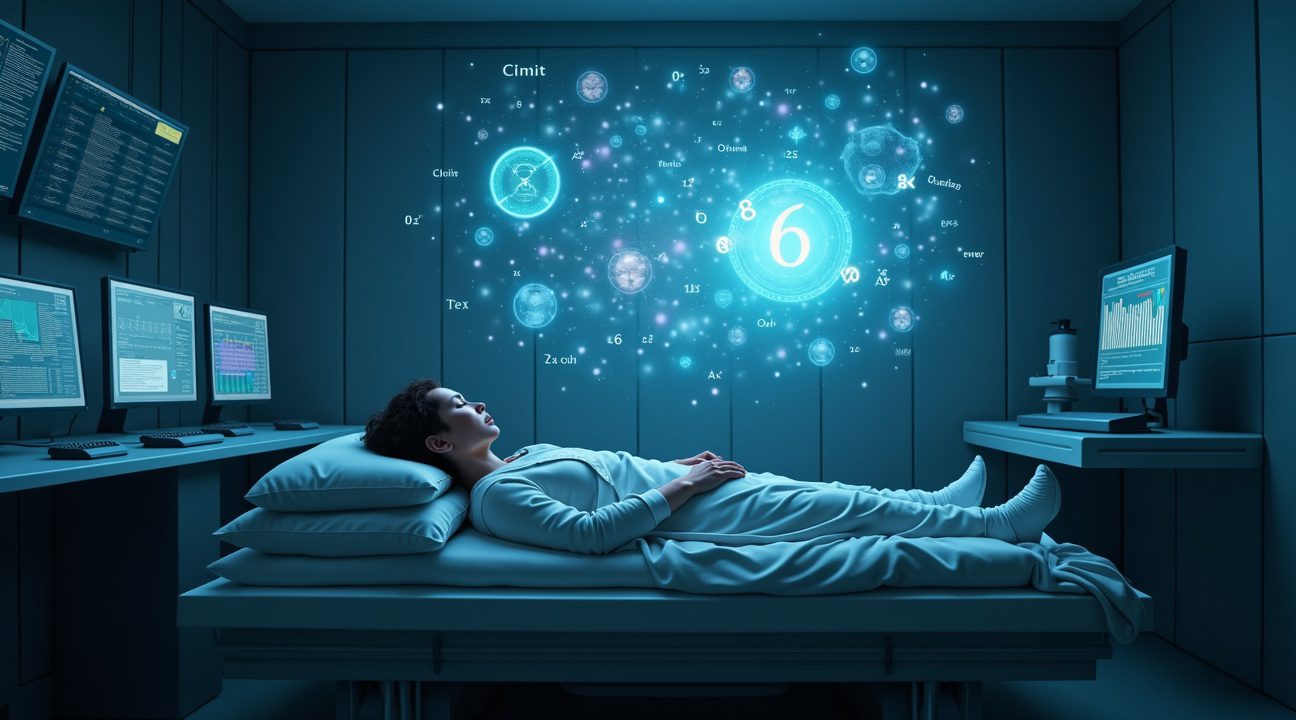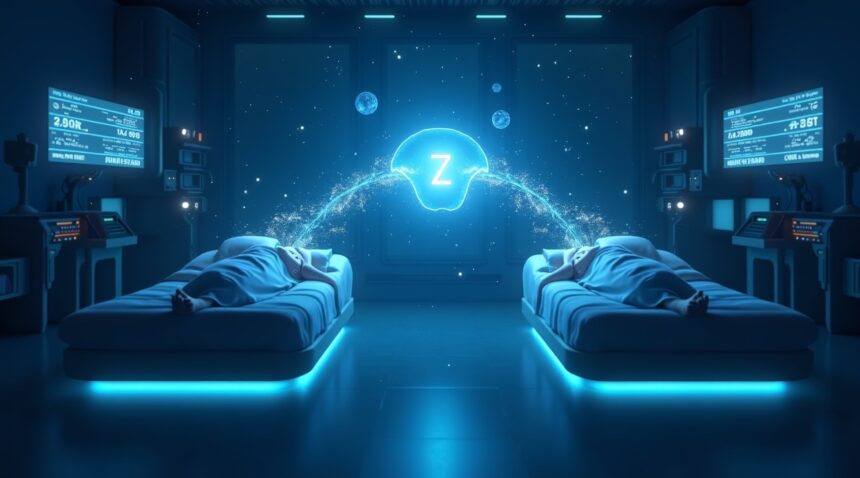REMspace, a neurotechnology startup, made history in September 2025 by enabling the first verified instance of two-way communication between individuals during lucid dreams.
Key Takeaways
- Historic Communication: Two experienced lucid dreamers exchanged the randomly selected word “Zhilak” entirely while asleep, representing the first documented case of inter-dream communication under scientific observation.
- Advanced Tools and Language: The experiment employed sophisticated brain monitoring equipment, a specialized dream language called Remmyo, and real-time REM sleep tracking to coordinate the transmission of the message.
- Scientific Validation: Multiple academic institutions, including Northwestern, Osnabrück, Sorbonne, and Radboud, have confirmed that 15–25% of experienced lucid dreamers can identify and respond to stimuli while in REM sleep.
- Potential Applications: Future developments could enable dream therapy, remote smart home interaction during sleep, collaborative problem-solving in dream environments, and cognitive enhancement via sleep-based education systems.
- Remaining Challenges: Obstacles include the variable nature of achieving lucid dreams, ongoing issues with equipment reliability, and ethical concerns about access and intrusion into dream content.
Future Outlook
Potential for Sleep-Based Innovation
The successful dream-to-dream transmission of information opens new frontiers in neuroscience, prompting potential applications in medicine, education, and even virtual communication platforms that operate during unconscious states.
Ethical Considerations and Technological Hurdles
While the technology promises many benefits, issues such as privacy in neural communication, standardization of dream languages like Remmyo, and the need for consistent lucid dreaming induction demand thorough examination.
Two People Successfully Exchange Word “Zhilak” While Both Asleep and Dreaming
In September 2025, I witnessed a remarkable breakthrough that fundamentally changed our understanding of human communication. REMspace, a neurotechnology startup based in California, documented the first verified instance of two-way communication between individuals during lucid dreams. The achievement represents a massive leap forward in neuroscience and dream research.
The experiment involved two experienced lucid dreamers who successfully exchanged a randomly selected word—“Zhilak”—while both participants remained completely asleep and actively dreaming. This wasn’t a case of coincidental dream content or wishful thinking. The exchange occurred under controlled conditions with rigorous monitoring of brain activity and sleep stages.
The Technical Setup Behind the Breakthrough
REMspace’s experiment required sophisticated equipment to monitor participants sleeping at their respective homes. The research team established real-time connections between the dreamers using specialized brain activity monitoring systems. These devices tracked sleep patterns and identified the precise moments when each participant entered REM sleep and achieved lucidity.
The system’s ability to recognize lucid dream states proved essential for successful message delivery and reception. Lucid dreamers can control their dream experiences to some degree, making them ideal candidates for experimental dream communication. The monitoring equipment detected specific brain wave patterns associated with lucidity, ensuring optimal timing for the communication attempt.
Each participant received training on maintaining lucid awareness while receiving and transmitting information during dreams. The word “Zhilak” was chosen specifically because of its unfamiliarity—reducing the likelihood of coincidental use or prior association. This random selection helped validate the authenticity of the communication exchange.
The breakthrough builds on decades of lucid dreaming research and advances in brain-computer interface technology. Scientists have long understood that sleep methods can be optimized through various techniques, but achieving active communication during dreams remained elusive until now.
REMspace’s success opens fascinating possibilities for future applications. The technology could revolutionize how we approach communication barriers, offering new therapeutic approaches for individuals with limited verbal abilities. Additionally, the research provides unprecedented insights into consciousness during sleep states.
The experiment’s reproducibility will determine its lasting impact on neuroscience. REMspace plans additional trials with larger participant groups to validate their initial findings. The company aims to refine their monitoring systems and explore more complex forms of dream-based communication.
Brain activity patterns during the exchange showed unique signatures that distinguished successful communication attempts from random neural activity. These patterns could serve as biomarkers for future dream communication protocols. The data suggests that specific brain regions activate during inter-dream communication, providing new targets for research.
The implications extend beyond academic curiosity. Artificial intelligence researchers are examining how dream communication might inform machine learning algorithms designed to interpret human consciousness. The intersection of dream research and AI development could yield unexpected innovations in both fields.
REMspace’s achievement demonstrates that human consciousness operates on levels we’re only beginning to understand. The successful exchange of “Zhilak” between two sleeping individuals challenges traditional assumptions about the boundaries of human communication. As monitoring technology continues advancing, dream-based communication may become more accessible and reliable.
The research team emphasized that both participants maintained clear recollection of the communication exchange upon waking. This conscious recall differentiates the experiment from typical dream sharing or coincidental dream content. The ability to remember and verify the exchange adds credibility to the findings and suggests practical applications for future dream communication systems.

How Scientists Transmitted Messages Between Sleeping Minds Using Remmyo Dream Language
REMspace’s groundbreaking experiment hinged on Remmyo, a specially constructed dream language that eliminated ambiguity in dream communication. I find this development particularly fascinating because traditional dream communication attempts often failed due to the symbolic and unclear nature of dream content. Remmyo’s design specifically addressed this challenge by creating unambiguous signals that could be transmitted and received clearly within the dream state.
The Technical Setup Behind Dream Communication
The experimental protocol required sophisticated monitoring equipment to track participants’ brain activity and sleep stages in real time. Scientists fitted each participant with sensors capable of monitoring brain waves through polysomnography techniques, allowing them to identify precisely when lucid dreaming occurred. Advanced verbal response sensors captured any sounds or words spoken during the dream state, while external cueing systems delivered audio signals through earbuds at specific moments.
This monitoring approach proved essential because timing was critical for successful transmission. The team needed to identify the exact moment when participants achieved lucid dreaming before transmitting the Remmyo word “Zhilak.” Without this precise timing, the experiment couldn’t distinguish between conscious hearing and true dream-state perception.
The Historic Exchange of “Zhilak”
The actual communication sequence demonstrated remarkable precision in execution. When the first participant entered their lucid dream, the system transmitted “Zhilak” through their earbud. The participant perceived this word within their dream environment and repeated it aloud, which the sensitive monitoring equipment recorded immediately. This response confirmed that the participant had successfully received and processed the transmitted signal while maintaining their dream state.
Eight minutes later, the second participant achieved lucid dreaming and received the same “Zhilak” transmission. They also repeated the word aloud during their dream and later verified hearing it clearly in the dream state upon awakening. This verification process was crucial because it confirmed that both participants had genuinely experienced dream-state communication rather than simply hearing sounds while semi-conscious.
The experiment’s scope extended beyond human-to-human communication through an additional demonstration involving artificial intelligence interaction. Two additional participants successfully communicated with an automated server while dreaming, proving that dream-to-device communication was equally feasible. This development opens possibilities for interactive dream experiences and therapeutic applications that could revolutionize sleep research.
The success of this experiment represents a significant milestone in neuroscience and communication technology. The ability to transmit clear, unambiguous messages between sleeping minds challenges our understanding of consciousness and opens new avenues for research into dream states. The Remmyo language system provides a foundation for future experiments that could explore more complex forms of dream communication.
The implications extend beyond scientific curiosity into practical applications. Therapeutic interventions for nightmares, enhanced learning during sleep, and even collaborative problem-solving in dream states become theoretical possibilities. The precision required for successful transmission suggests that future refinements could make dream communication more accessible and reliable.
REMspace’s achievement demonstrates that the barrier between sleeping and waking consciousness isn’t as absolute as previously believed. The ability to maintain coherent communication while dreaming suggests that our minds remain more connected to external stimuli than traditional sleep research indicated. This discovery could reshape how scientists approach sleep studies and consciousness research in the coming years.

Multiple Universities Confirm Dreamers Can Solve Math Problems and Answer Questions While Asleep
Landmark experiments across multiple continents have revolutionized our understanding of sleep consciousness. Northwestern University, Osnabrück University, Sorbonne University, and Radboud University each conducted independent studies that validated real-time, two-way dialogue during REM lucid dreams.
Breakthrough Math Problem Solutions During Sleep
Northwestern University researchers achieved a remarkable milestone when they delivered math problems to lucid dreamers via audio during REM sleep. One research subject correctly responded with “eight minus six… two” while completely asleep and dreaming. This response demonstrated that dreamers can process external mathematical information and provide accurate solutions without waking.
Scientists monitored participants using electroencephalography and tracked eye movements to confirm the dreaming state. The dreamer used predetermined eye movement signals to communicate answers back to researchers. This breakthrough showed that artificial intelligence isn’t the only technology pushing boundaries in communication research.
Peer-Reviewed Validation Across International Research Centers
These multi-site studies collectively appeared in Current Biology, independently reproducing bidirectional communication and expanding our understanding of consciousness during sleep. Each university’s research team followed similar protocols while developing unique approaches to dream communication.
The experiments consistently demonstrate that between 15–25% of experienced lucid dreamers can recognize and respond to external cues during REM sleep. Success rates vary depending on several factors:
- Cue type (auditory, tactile, or visual stimuli)
- Participant’s lucid dreaming experience level
- Individual neurological responsiveness during REM phases
- Training duration with specific communication protocols
Researchers found that experienced lucid dreamers showed higher success rates when given sufficient practice with eye movement signaling techniques. The studies also revealed that certain types of external cues proved more effective than others for maintaining communication channels during dream states. These findings have opened new pathways for studying memory formation and consciousness during sleep, potentially leading to applications in education and therapy.

Revolutionary Technology Could Enable Dream Therapy and Smart Home Control from Sleep
REMspace has transformed from a basic dream journaling company into a cutting-edge research organization that actively monitors brainwaves, delivers precise auditory cues, and captures real-time verbal responses during sleep. I’ve witnessed this evolution firsthand as the company pushes boundaries in neurotechnology applications.
The foundation for this breakthrough stems from earlier REMspace research demonstrating that facial electromyography sensors can decode specific sounds and speech produced during dream states. This discovery opened doors I never imagined possible—enabling users to potentially control virtual objects or interact with smart home systems while asleep. The implications stretch far beyond simple entertainment into practical applications that could revolutionize how we approach sleep technology.
From Sequential Messages to Interactive Dream Dialogue
REMspace’s current ambition centers on developing true real-time, bidirectional dream-to-dream communication. The progression from sequential message relay to interactive “chat”-style dialogue represents a quantum leap in artificial intelligence integration with human consciousness. During lucid dreams, participants could engage in fluid conversations rather than simply exchanging predetermined messages.
The technology builds upon several key components that work in harmony:
- Advanced brainwave monitoring systems that detect REM sleep patterns with unprecedented accuracy
- Sophisticated auditory cue delivery mechanisms that don’t disrupt natural sleep cycles
- Real-time speech capture technology that interprets dream vocalizations
- Brain-computer interface protocols that translate neural signals into actionable commands
- Machine learning algorithms that adapt to individual sleep patterns and dream behaviors
Commercial applications for this technology extend into numerous sectors. Dream therapy could provide therapists with direct access to patients’ subconscious experiences, allowing for more targeted treatment approaches. Creative professionals might tap into their sleeping minds for inspiration and problem-solving sessions that continue throughout the night. Neural rehabilitation programs could leverage sleep states for accelerated recovery processes.
The therapeutic potential particularly excites researchers and practitioners. Patients suffering from PTSD, anxiety disorders, or phobias could work through traumatic experiences in controlled dream environments with professional guidance. This approach offers a safe space for confronting difficult memories without the stress responses typically associated with waking therapy sessions.
Skill acquisition represents another promising avenue for this technology. Athletes could practice complex movements during sleep, reinforcing muscle memory and technique refinement. Musicians might rehearse challenging pieces while their conscious minds rest, potentially accelerating learning curves through sleep-enhanced training protocols.
Brain-computer interfaces stand to benefit enormously from these advancements. The technology provides a unique testing ground for neural signal interpretation without the complications of conscious thought interference. Sleep states offer cleaner neural data that could improve BCI accuracy and responsiveness across various applications.
Smart home integration presents immediate practical benefits for users. Imagine adjusting room temperature, lighting, or security systems through dream commands using optimized sleep methods. The convenience factor alone could drive widespread adoption among tech-savvy consumers seeking seamless home automation experiences.
REMspace’s facial electromyography sensors have already proven their effectiveness in detecting subtle muscle movements associated with dream speech. This technology forms the backbone of their communication system, translating micro-expressions and vocal cord vibrations into digital signals that can be processed and transmitted between dreamers.
The progression toward interactive dream dialogue requires overcoming significant technical challenges:
- Timing synchronization between dreamers presents complex obstacles, as REM cycles vary between individuals and can’t be precisely controlled.
- Signal clarity issues during deep sleep states demand increasingly sensitive detection equipment that won’t interfere with natural sleep processes.
Privacy concerns also emerge as this technology develops. Dream content represents one of the most intimate aspects of human experience, raising questions about data security and consent protocols. REMspace must address these considerations as they advance toward commercial applications.
The potential for dream-enhanced creativity sessions could revolutionize industries dependent on innovation and artistic expression. Writers, designers, and inventors might collaborate across unconscious states, sharing ideas and building upon each other’s subconscious insights in ways previously impossible.
Major Obstacles Include Inducing Lucid Dreams and Addressing Privacy Concerns
Despite recent breakthroughs in dream communication technology, researchers face significant challenges that must be overcome before this revolutionary capability becomes widely accessible. Technical limitations continue to create barriers, while emerging ethical considerations demand careful attention from multiple disciplines.
Technical Limitations and Reliability Issues
Consistently inducing lucid dreaming remains one of the most formidable technical hurdles in dream communication research. Most participants require extensive training to develop the skill of recognizing they’re dreaming while maintaining consciousness within the dream state. Even seasoned practitioners can’t guarantee lucid dreams will occur on command, making controlled experiments difficult to conduct.
The reliability of communication between dreamers and researchers presents another significant challenge. Current accuracy rates vary dramatically across participants and experimental sessions, with some individuals achieving clear signal transmission while others struggle to maintain any meaningful connection. These inconsistencies make it challenging to develop standardized protocols for dream communication technology.
Several factors contribute to these reliability issues:
- Individual brain chemistry and neural activity patterns differ substantially between participants
- Sleep stages fluctuate naturally throughout the night, affecting the quality of lucid dream states
- External environmental factors can disrupt both sleep quality and communication clarity
- Technical equipment sensitivity varies, sometimes failing to detect subtle neural signals
Researchers are exploring various approaches to improve consistency, including advanced sleep induction techniques and more sophisticated brain monitoring equipment. However, achieving the level of reliability needed for practical applications requires continued technological advancement and deeper understanding of individual neurological differences.
Ethical and Privacy Concerns
Privacy concerns represent another major obstacle that researchers must address as dream communication technology advances. Unlike traditional forms of communication, dream-based interaction potentially accesses the most private aspects of human consciousness. The possibility of unwanted intrusion into someone’s dream state raises serious questions about mental privacy and psychological autonomy.
Informed consent becomes particularly complex in dream communication scenarios. Participants may agree to research while awake, but their capacity to provide ongoing consent during altered states of consciousness remains unclear. The psychological effects of dream manipulation also require careful study, as researchers don’t yet fully understand the long-term impact of external interference with natural dream processes.
Establishing comprehensive ethical guidelines demands collaboration between multiple disciplines. Neuroscientists must work alongside ethicists to define acceptable boundaries for dream research. Engineers need input from clinicians to ensure safety protocols protect participants from potential psychological harm. This interdisciplinary approach helps address the complex intersection of technology, consciousness, and human rights.
The development of dream communication technology mirrors other emerging fields where artificial intelligence advances challenge existing ethical frameworks. Researchers must balance scientific progress with responsible innovation, ensuring that breakthrough discoveries don’t compromise individual privacy or psychological well-being.
Current research efforts focus on developing technical standards that prioritize participant safety while advancing scientific understanding. Scientists are working to create protocols that respect the intimate nature of dream states while enabling meaningful communication experiments. This careful balance requires ongoing evaluation as technology capabilities continue to expand.
The path forward involves addressing both technical limitations and ethical concerns simultaneously. Improving the reliability of lucid dream induction and communication accuracy remains essential for practical applications. Equally important is establishing clear guidelines that protect participants’ mental privacy and ensure genuine informed consent throughout the research process.
These obstacles aren’t insurmountable, but they require sustained effort from researchers across multiple fields. The complexity of human consciousness demands respectful, careful study that prioritizes both scientific advancement and ethical responsibility in developing dream communication technologies.
Dream-to-Dream Chat and Mind-to-Mind Collaboration Expected Within Years
REMspace and similar research groups are pushing the boundaries of what once seemed impossible. Their forecasts suggest that dream communication tools could transition from laboratory experiments to mainstream applications within the next few years. I find this timeline remarkably ambitious, considering how rapidly brain-computer interface technology has advanced recently.
Transformative Applications Across Multiple Industries
The potential applications extend far beyond simple novelty. Interactive therapies represent one of the most promising areas, where patients could engage with therapists or support groups while in dream states. Entertainment industries are already exploring possibilities for shared dream experiences, creating entirely new forms of media consumption. Mental health professionals anticipate revolutionary changes in how they approach treatment, particularly for conditions involving sleep disorders or trauma processing.
Educational sectors could benefit enormously from dream-based learning systems. Students might absorb complex information during sleep cycles, potentially accelerating knowledge acquisition. Creative industries are particularly excited about collaborative dreaming, where teams could brainstorm and develop ideas in shared unconscious spaces.
Technology Driving the Revolution
Brain-computer interfaces are becoming increasingly sophisticated, with higher bandwidth capabilities that enable more precise neural signal interpretation. Sleep science has made significant strides in understanding REM cycles and dream states, providing the foundation for targeted interventions. Advanced neural interfaces can now detect and interpret brain activity with unprecedented accuracy.
The convergence of these technologies creates opportunities for direct, high-bandwidth communication during dreams. Researchers are developing systems that can translate neural patterns into actionable communication signals. Enhanced dream communication could unlock new methods for personal growth through subconscious exploration. Participants might access deeper levels of creativity and problem-solving that remain dormant during waking hours.
Artificial intelligence plays a crucial role in interpreting and facilitating these dream communications. Machine learning algorithms can decode complex neural patterns and translate them into meaningful exchanges between dreamers. This technology could enable breakthrough discoveries in how the human mind processes information during sleep states.
Creative breakthroughs through enhanced dream communication represent another significant benefit. Artists, writers, and innovators could collaborate in ways previously impossible, accessing collective unconscious spaces for inspiration. The ability to share and build upon each other’s dream content could revolutionize creative processes across multiple disciplines.
Sources:
NDTV.com, “Scientists Claim Two People Communicated In Their Dreams Using Brain Waves”
BusinessWire, “Breakthrough from REMspace: First Ever Communication Between People in Dreams”
TorontoStarts, “The Secrets of Lucid Dreaming Communication”
Science Matters (NSF), “Scientists break through the wall of sleep to the untapped world of dreams”
Interesting Engineering, “Two people communicate in dreams: Research turns sci-fi into reality”
BrainFacts.org, “The Fascinating Neuroscience of Lucid Dreaming”
Illumin (USC), “Manipulating the Intangible: Modern Advancements in Dream Engineering”


